UTILIZATION OF "DAKSINA" COCONUT WASTE FOR COCONUT BONSAI PLANTS, # HAPPY AT HOME
30/06/2020 Views : 861
KETUT DHARMA SUSILA
Various efforts have been made in dealing with the Covid-19 pandemic. But the most important thing is how we take care of each other's thoughts, hearts and feelings, so that we can remain grateful, creative, smiling and not forgetting to be happy, and kept away from worry; excessive fear; stress; let alone panic, so that our immunity (immunity) is maintained. The maintained immunity of the body must be believed as one of the weapons against this Corona virus. In addition, of course, do not forget we must continue to maintain healthy food and beverage intake and implement health protocols according to the government's appeal / advice.
While staying and working from home, there are many positive activities that can be done so that we can still smile happily, and take advantage of our free time to avoid being bored and at risk of exposure to Covid-19. One of the positive activities is to run a hobby or activities that make us feel happy and peaceful, for example making ornamental plants with bonsai techniques.
Bonsai is a technique for stunting trees from Japan. Bonsai is one of the art of farming carried out with the aim to stunt plants that are suitable for home-based agricultural activities in urban areas. For lovers of ornamental plants, there are many types of plants that can be used as bonsai. Many types of trees can be used as bonsai plants, one of which is a bonsai palm tree.
The Balinese who are Hindus are already very familiar with the word "daksina", namely banten which is used as a symbol of offerings / thanks in the form of scale and noetic. Daksina lexically has the meaning of "offering" (Hindu Dictionary) which further means, "what is sincerely given / offered from one's abilities". Banten daksina consists of various components, including coconut that has been clean from the husk. Coconut shell in daksina, likened to a symbol of the sun. Generally after the religious ceremony is finished, a lot of coconut waste is produced from the daksina that has been "warped" after being offered. Well, this daksina coconut waste is used to be grown into ornamental plant seeds in the form of coconut bonsai which can be done at home as a memento in the Covid-19 pandemic. The stages of making coconut bonsai can be followed as presented below:
1. Coconut waste from Daksina is collected and selected which is not rotten
The advantage of using daksina coconut waste, which is that the coconut shell is clean from its husk, so that we don't need to bother to clean the husk and fine hair on the shell.
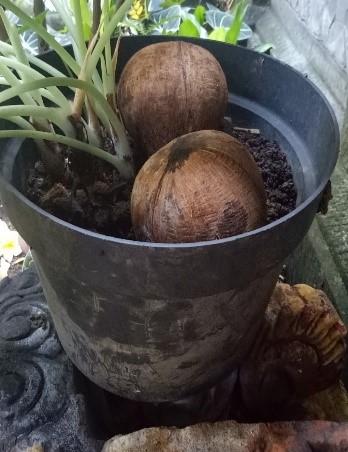
2. Preparing the Coconut for Sprouting
Prepare coconut tree seedlings to sprout, need a few weeks to leave the coconut fruit in moist and cool soil. Should not be exposed to direct sunlight, so that the coconut shell does not break. Putting the coconut fruit need to be considered because it affects the position of the shoot.
Coconut fruit that is placed standing or vertically will usually sprout with roots that surround the coconut shell. Meanwhile, if the coconut shell is placed horizontally, the bud will appear on the side so that the coconut shell looks like a snail house.
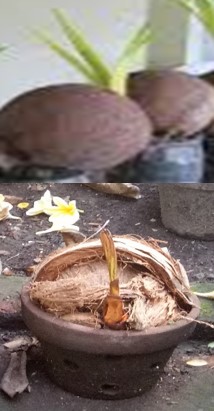
3. Preparing the Growing Media
How to make or prepare planting media is as follows: prepared a relatively small size pot according to the size of the coconut shell then fill with a mixture of soil and manure, with a ratio of 1: 1. If it is filled, prepare a used bottle of mineral water to be used as a cover for the coconut buds so that it can develop quickly. The top of the bottle is cut to a height of approximately 5cm. Coconut sprouts can be directly put into a pot containing a mixture of soil and manure media.
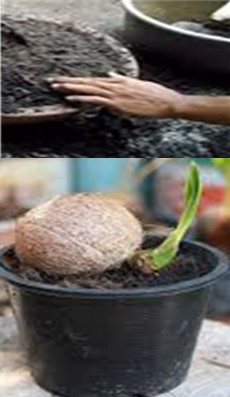
4. Coconut Bonsai Plant Formed
When the seedlings have grown to 15 to 20 cm, they need to be sliced off at the bottom of the shoot. Be careful, so young shoots don't get cut so they don't rot. Cutting is done every 3 days so that the plants do not grow large.
Then, how to form the roots of the coconut bonsai so that it has a beautiful and attractive shape, which is to try to tie it with wire or rope. Wire ties or ropes will direct the growth of twigs from this coconut bonsai. Usually the tips of the branches are attached to the base of the stem. Meanwhile, cutting branches is done to get rid of unwanted branches.
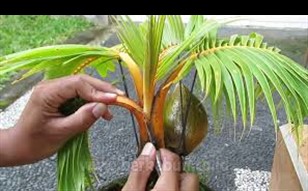
5. Care of Coconut Bonsai Plants
After the steps of making coconut bonsai, the treatment is done. Maintenance is quite easy. Coconut bonsai plants are sufficiently watered once a day ie, in the morning or evening. However, during the dry season it is advisable to water it more frequently so it does not dry out. In addition to watering coconut bonsai also need to be given fertilizer. Fertilization can be done every 15 days. Use of insecticides or herbicides if needed, so that the coconut bonsai plants avoid pests (plant-disturbing organisms).
Some of the results of nurseries of coconut bonsai from "daksina" coconut waste that have been successfully tried at the author's home based on personal experience during WFH (work from home ), presented in the image below. So that can be conveyed, hopefully useful and good luck. Greetings Rahayu for all fans of bonsai plants.
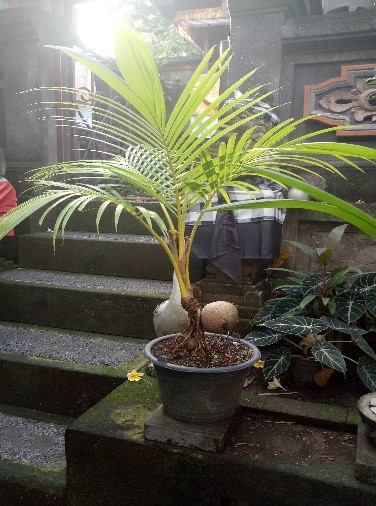
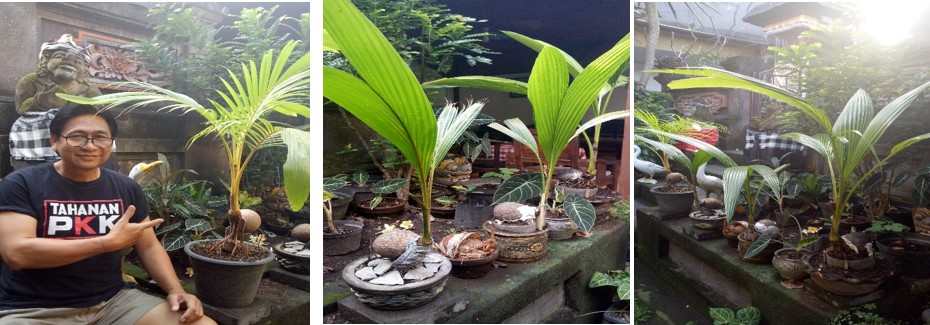
----------------------------------------------------------------------------------------------------------------------------------------------------------------------------------------
(Created by: K. Dharma Susila as an assignment for FP-UNUD Agroecotechnology Webinar and Workshop).
